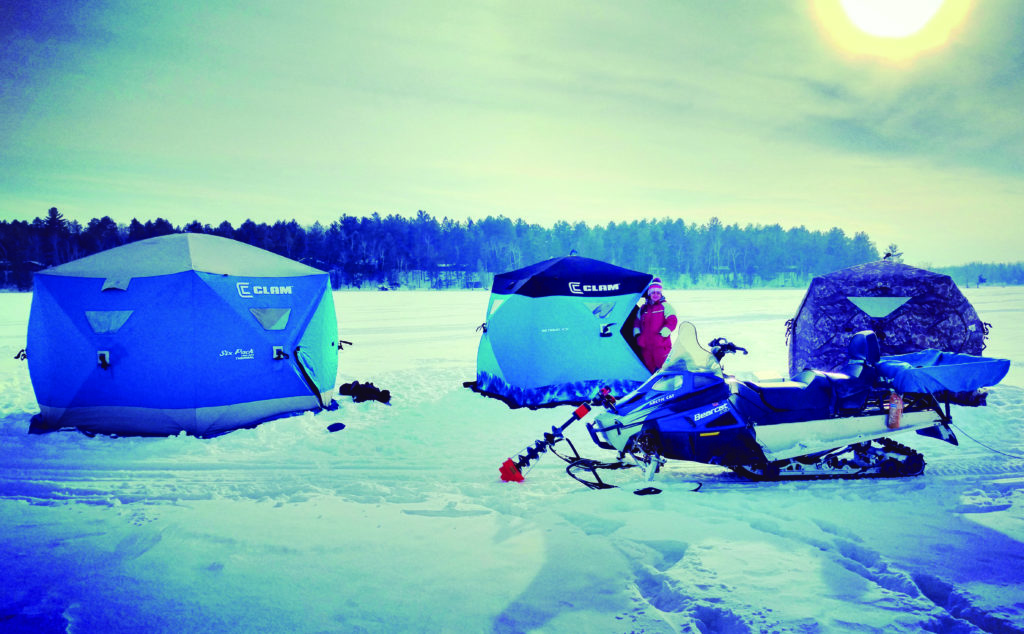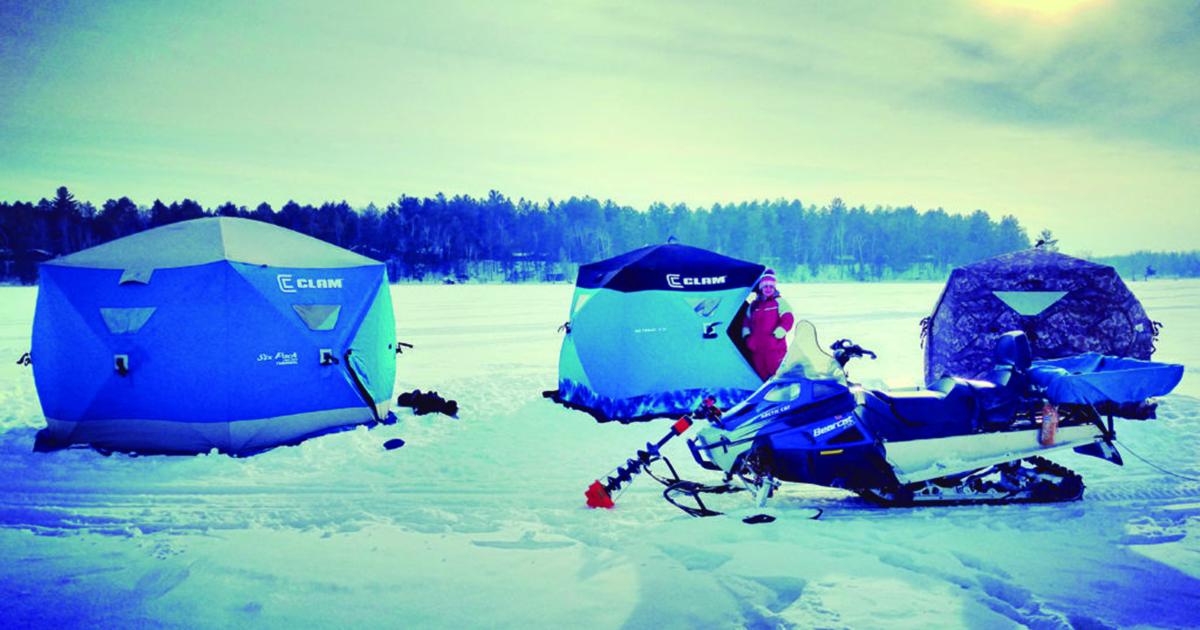The 2018-2019 ice fishing season was a lesson in frustration throughout most of the Ice Belt. Record snowfall totals led to deep-slush conditions that persisted throughout winter. Even when the deep snow cover and slush finally started to melt away in March, the receding water created rotten ice that was only safe for a couple of late-season weeks in many areas.
“I’ve been ice fishing my whole life, since I was about 2 years old, and I’ve been guiding for 17 years, and I’ve never dealt with ice conditions like that before,” said North Country Guide Service Owner Matt Breuer, of Bemidji, Minnesota. “I’ve dealt with slush and slush pockets and years when the slush was bad, but I’ve never had to endure that much snow, and then that much water and slush. It wasn’t pockets; it was entire lakes.”
Rapala Ice Pro Brad Hawthorne said that the only season he remembers that compared, in terms of challenging ice conditions, was the 2013-2014 ice fishing season, which he spent guiding primarily on Upper Red Lake in northern Minnesota. That year, extremely cold conditions followed by warming (and vice versa) led to major cracks on the lake ice, water bleeding up through those cracks and then huge pockets of slush.
For Hawthorne, who runs Hawthorne’s Guide Service on Minnesota’s Lake Mille Lacs, and Breuer, an Ice Team Pro, ice fishing isn’t just about having fun; it makes up a good part of their livelihoods. So even when the conditions are almost unbearable, like last winter, they have to figure out how to get their clients out on the ice, keep them safe and dry, and put them on fish. Having spent the better part of the last two decades doing just that means both guides have learned more than a few tricks to fish through deep-slush conditions without completely ruining their days. Since more of my ice fishing days last winter were completely ruined than I care to admit, I listened closely to the guides’ advice and put together a list of the most helpful tips they shared.
1. BE PREPARED
Both Breuer and Hawthorne emphasized the need to know the ice and slush conditions before you go out and to be prepared for them. If you aren’t sure exactly what the conditions are like, there’s no better place to start than the local bait shop.
“They’ll be able to advise you on what to do and where to go,” Hawthorne said. “Those folks, because they talk to thousands of people a week that are heading out that have tried it, they’re going to be able to give you your success rate, like, ‘You have zero chance’ or, ‘Yeah, a couple guys are going out. Wheelers are getting stuck, but the guys on the snowmobiles are fine.’”
After you have an idea what the conditions are like, you can mentally prepare for what you’ll be facing and weigh whether you’re up for the hassle. It’s much easier to turn around and drive home on solid ground than it is when your snowmobile is stuck in a foot of water and slush.
2. USE A LIGHT SNOWMOBILE (OR A HEAVY ONE)
During a large portion of last ice fishing season, travel was restricted to snowmobiles. Plow drivers couldn’t keep the roads unflooded for trucks, and the snow and slush were too deep for four-wheelers and most track machines.
All snowmobiles are not created equal, though. For getting through the deepest slush, Breuer and Hawthorne agree that the middle-weight sleds just don’t cut it.
“You’ve got two options,” Breuer said. “Going with something like a utility sled that’s really heavy with a really wide and really long track, something like a [Arctic Cat] Bearcat. It’s going to give you wider paddles, a wider track, a longer track. It’s going to give you bigger skis to help you stay on top. You’ve got that option. Otherwise, the next option would be going to something super light, like maybe an older sled that hardly weighs anything. That can be beneficial as well, because it allows you to run across a lot faster without depressing into the snow too much.”
The light machines are more likely to get stuck than the utility sleds, but they’re much easier to get unstuck.
“My Bearcat goes through pretty much anything,” Breuer said. “But if you get a Bearcat stuck, it’s stuck. It’s tow-truck stuck.”
3. TRAVEL LIGHT
It might seem obvious, but it has to be said: In extreme slush conditions, it’s advantageous to travel as light as possible. That might mean leaving the portable shelters behind, and it could also mean making multiple trips.

If you absolutely can’t leave the sled or portable shelter behind, Hawthorne advises putting the bulk of the weight toward the back of the sled.
“That’s going to do two things,” he said. “It’s going to keep the back end of that thing down and keep the front end up. And if you can do that, maintain that, what that does is build a really good trail for yourself as well.”
4. STAY STRAIGHT, GO FAST
When you do hit a pocket of deep slush, it’s best to keep the snowmobile straight and punch the gas.
“Accelerate and just hang on,” Breuer said. “It literally is just kind of a rodeo situation where you buckle down and hang on for dear life. If you stop or slow down, it’s over.”
While Hawthorne gives the same advice, he offers it with one caveat: You have to be sure that you’re not charging ahead onto unsafe ice.
“If you know that there’s adequate ice under there and it’s just slush, yeah, gun it,” he said.
5. SPOT THE SLUSH, AVOID IT
In years with normal snow fall, the snow cover in slushy areas will typically appear a bit darker, and the area will be slightly sunk, usually in the shape of a circle. It’s often possible to spot these slush pockets and avoid them.
Extremely deep snow, like we experienced last year, can complicate things significantly, though.
“I honestly couldn’t tell at all where the slush was going to be,” Breuer said. “It was just one of those things where you’d be driving along and everything looked kind of status quo, and all of a sudden, you would just dump into it.”
Strangely, in deep snow, it’s often the mounded, higher areas that are most likely to be covering the deepest slush, according to Hawthorne. He said this might be because blowing snow sticks to the wet snow in those areas and slowly builds up circular mounds. He sticks to the lower areas in hopes of avoiding the slush pockets.
6. PACK DOWN A TRACK
Hawthorne’s go-to tactic for keeping his guide trips running smoothly in spite of deep slush is to build a frozen road out to the spot he plans to fish a day or two before the trip.
“If I knew that I had to guide on a lake, on a small body of water, what I would do the day before or two days before would be to go out with my snowmobile and beat down a trail at high speeds, you know, try to keep going fast enough so that you’re not going to get stuck, and just keep going back and forth and get a track down,” Hawthorne said.
For these packing missions, he traveled extremely light and cruised back and forth from the lake access point to the fishing location at 30 to 40 miles per hour. Each time, he’d follow the same track but stay 50% over it to help widen the path.
Because there was no longer any snow insulation, the slush in the tracks Hawthorne packed down would freeze overnight or during the next day, creating a solid, frozen path for travel.

“Once you compact the snow and the slush, it tends to freeze a lot faster, so at least you have an A and B out of there,” Hawthorne explained. “And if you were able to let it sit for two days, you literally had a road because, once it froze, it was not going to thaw out.”
7. TAKE THE SAME ROUTE BACK
If you make it out to your fishing spot without getting stuck, don’t get creative and try a different route back to shore when you’re done fishing. That path worked once; it should work again. Breuer stays out of the exact path he packed down on the way in, though, opting instead to run parallel to it, about 10 or 15 feet off the initial trail.
“If you go straight back through, you’re bottoming out even more, and you’re pushing even more slush and water,” Breuer explained.
8. BRING GEAR TO GET UNSTUCK
When the conditions are ripe for snowmobiles to get stuck, you have to plan on being able to get yours unstuck. That starts with bringing along a shovel, which is good advice no matter what the conditions are. The next step is equipping your machine with a winch or packing a come-along.
“I have an attachable winch on my snowmobile, UTV and my four-wheeler,” Hawthorne said. “That has proven — PROVEN — to have saved my bacon many, many times in those conditions.”
Along with the winch, Hawthorne packs a metal bar with two D-rings attached to it — one on the end and one in the middle.
“Basically what that does is, if I get stuck and there’s nothing to tie on to, you have to drill a hole and you put this bar down the hole,” Hawthorne explained. “The D-ring on the end of the bar is connected to a rope, and then the middle ring is connected to your winch cable.
“You drop that down a hole, make sure it’s centered in the hole and then put tension on your winch cable and make sure that it’s locked in that hole. That’s a great method of extracting from deep slush.”
A come-along is essentially a hand-operated version of the winch and can be just as useful.
“If I can get one sled parked on packed snow versus slush, I can park that sled, walk the come-along back and then try to pull the other sled out,” Breuer said.
9. CLEAR IT OFF
After traveling through slush, it’s a good idea to try to clear off as much of it from your snowmobile as possible. Simply accelerating through a drier area will clean off a good portion of it. If you still notice some accumulation after you stop, it’s better to take a couple of minutes to clear it off than to find that it’s frozen solid an hour or two later. Ice will wreak havoc on almost every machine.
Hawthorne has one other trick he uses to help keep his sleds clear — cooking spray. He admits that it’s not for everyone, but by spraying the underside chassis of his machines with Pam or a similar cooking spray every few weeks, much less snow and slush will stick to those sleds.
“You have to reapply that several times throughout the season, but for the most part, it keeps that ice and snow from really getting in there, so you don’t have to bring your machine in and thaw it out for a day and a half in your garage,” he said.
10. BE CONSIDERATE
When conditions have deteriorated down to the most difficult to traverse, people often take shortcuts. What they often don’t realize is that those shortcuts can have a huge impact on others, and even make the ice fishing season tougher on themselves. During any season, and especially a season like last winter with record snowfalls and deep slush, being considerate should start with those who keep the roads open on the ice.
“If you see a plow truck driver, you should be throwing them some cash because they’re the ones who are making it possible for you to fish during winters like this past one,” Breuer said.
It’s also extremely important that you don’t undo a plow truck driver’s hard work by drilling too close to a plowed road, drilling in plowed-out parking areas or punching holes right next to fish houses. All of these situations lead to flooding and a ton of extra work for the plow truck drivers.
FISH ANOTHER DAY
These tips should all help you get out and ice fish in deep-slush conditions, but even the pros know that some days they’re better off just staying on dry land. If the conditions require too much extra work or it’s simply not safe — it’s better to fish another day.
“No fish is worth dying over, No. 1,” Breuer said. “And no fish is worth having to spend several hundred dollars on repairs or rescues or anything like that. So use your head. There was a point last year where it was smarter to just stop fishing than it was to continue on. It’s the Ice Belt; we will get to ice fish again next year.”


